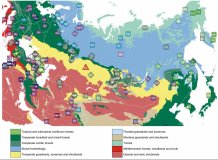
The research shows there are three distinct genetic groupings
Genetic data allows detailed picture of the history of inner Eurasia to be revealed for the first time
An international team of researchers has used genetic data from hundreds of people – as well as archaeological finds – to construct the most detailed picture of the history of inner Eurasia for the first time.
The study shows the indigenous populations of inner Eurasia are very diverse in their genes, culture and languages, but divide into three groups that stretch across the area in east-west geographic bands.
The team of academics – including Professor Alan Outram, an archaeologist from from the University of Exeter, used archaeological, historical and linguistic data with genetic information from over 700 newly analyzed individuals.
Inner Eurasia, which includes areas of modern-day Armenia, Georgia, Kazakhstan, Moldova, Mongolia, Russia, Tajikistan, Ukraine and Uzbekistan, was once the cross-roads connecting Asia and Europe, and a major intersection for the exchange of culture, trade goods and genes in prehistory and historical periods, including the era of the famous Silk Road.
This vast area can also be divided into several distinct ecological regions that stretch in largely east-west bands across Inner Eurasia - deserts at the southern edge of the region, the steppe in the central part, taiga forests further north, and tundra towards the Arctic region. The research shows there are three distinct genetic groupings, which geographically are arranged in east-west bands stretching across the region and correlating generally to ecological zones.
The northernmost grouping, which they term “forest-tundra”, includes Russians, all Uralic language-speakers, which includes Hungarian, Finnish and Estonian, and Yeniseian-language speakers, of which only one remains today and is spoken in central Siberia. The middle grouping, which they term “steppe-forest”, includes Turkic- and Mongolic-speaking populations from the Volga and the region around the Altai and Sayan mountains, near to where Russia, China, Mongolia and Kazakhstan meet. The southernmost grouping, “southern-steppe”, includes the rest of Turkic- and Mongolic-speaking populations living further south, such as Kazakhs, Kyrgyzs and Uzbeks, as well as Indo-European-speaking Tajiks.
“Inner Eurasia is a perfect place to investigate the relationship between environmental conditions and the pattern of human migration and mixture, as well as changes driven by cultural innovations such as the introduction of dairy pastoralism into the steppe,” states Choongwon Jeong of the Max Planck Institute for the Science of Human History, co-first and senior author of the paper.
Researchers carried out more than a 100 field trips as part of the project, reaching communities speaking almost all of the Inner Eurasian languages. They analyzed DNA from 763 individuals from across the region and reanalyzed the genome-wide data from two ancient individuals from the Botai culture. They compared those results with previously published data from modern and ancient individuals.
The study shows shifts in ancestry in the past that reveal previously unknown interactions. For example, the researchers found that the southern-steppe populations had a larger genetic component from West and South Asia than the other two groupings. This component is also widespread in the ancient populations of the region since the second half of the first millennium BC, but not found in Central Kazakhstan in earlier periods. This hints at a population movement from the southern-steppe region to the steppe-forest region that was previously unknown.
Two ancient individuals resequenced in this study originated from the Botai culture in Kazakhstan, where the horse was initially domesticated. Analysis of the Y-chromosome (inherited along the paternal genealogical lines) revealed a genetic lineage which is typical in the Kazakh steppe up to the present day. But analysis of the autosomes show no trace of Botai ancestry left in present-day people, likely due to repeated migrations into the region both from the west and the east since the Bronze Age.
The genetic history of admixture across inner Eurasia is published in the journal Nature Ecology & Evolution.
Date: 1 May 2019
